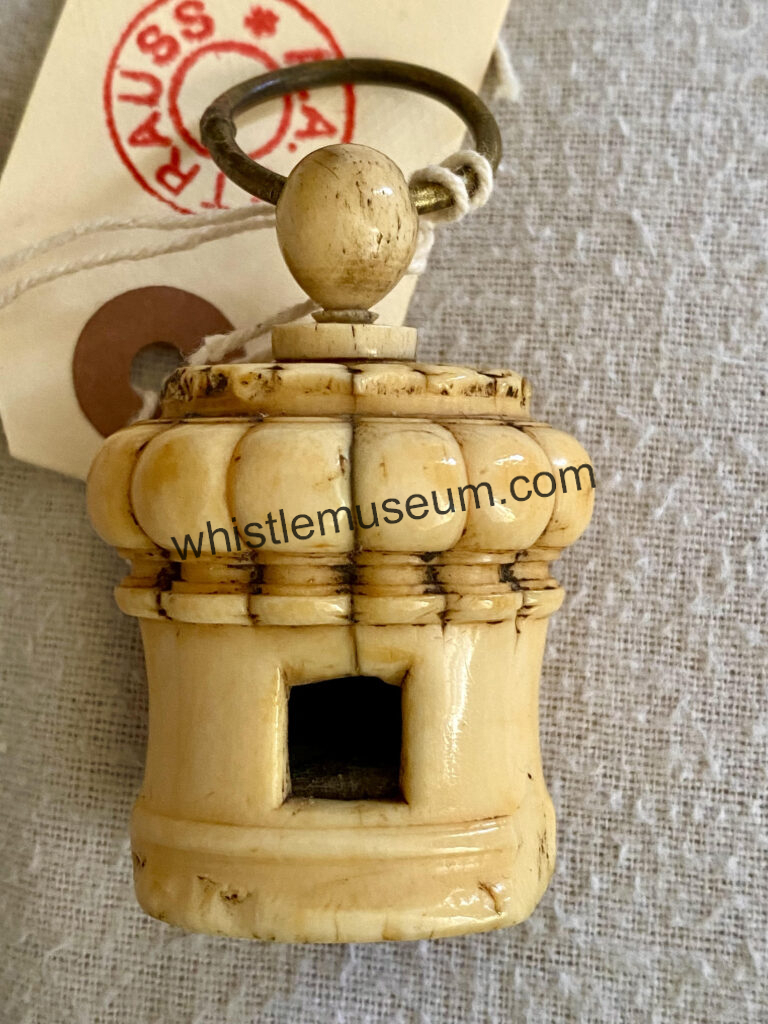
size app. 2″ by 1.5″
Antique whistle review
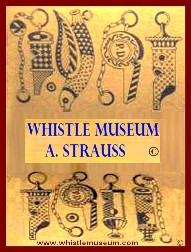
Part III a (See Part I & II William & George Dowler
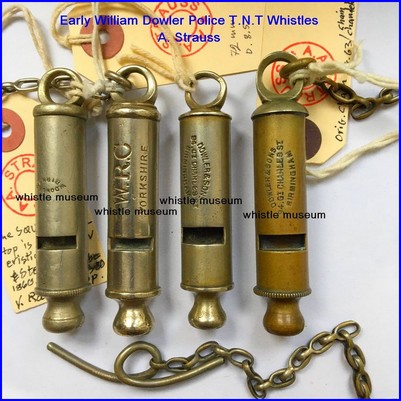
Intro
This article (Part III a) focuses on the Birmingham Whistles,
Military Ornaments and Button manufacturer William Dowler, later ‘William Dowler & Sons’. It is the continuation of the first article, and an on going research of 15 years, some of the first finds were posted here in 2008 and in the Wikipedia
and in 2015- 2016 a revised article about the family which established their business in 1776.
See Link, William & George Dowler which presented
the family’s history and work.
George Dowler had the bigger manufacturing plant and
manufactured whistles which were advertised but not identified to this day, continuing the family’s plants & manufacturing business up to 1870,
it was ‘Willian Dowler’ who was the bigger Whistle manufacturer, He started working independently in 1853 and took over the family’s assets in 1876.
In fact seeing the whole picture we can say that since 1853 William took an independent path and only in 1876 after legal fights gained control of the other various family plants and assets which George was running up to 1870.
Thus between the years 1853 – 1870 There were two different manufacturers;
one is Dowler – Birmingham, the other W. Dowler -Birmingham.
Georgian Period Whistles, British made whistles in the Pre Victorian times were a theme I was interested in for over a decade, New antique whistles surface here and there and throw light on the development of ‘Professional’ Round whistles, time line and makers, of which little is known about. *
But these certainly give a new perspective to the term IRONMONGERS in the 17th 18th 19th century who were making whistles, and which later became more Brass Founders I believe.
Before I put many of the thoughts, comments & observations on these,
I share some of mine and others, Needless to say all very rare.
Starting with a Trio of Military whistles from my own collection,
most possibly by J. Dixon of Sheffield very early 1800, These include few amazing features for the whistle student and scholars who have a keen eye.
The sound is of each one is outstanding, (I am tempted to say the best I heard ) Interestingly the trio forms the sound of a triad chord,
I will edit and add comments later.(There is a LOT to be said and learn)
= Continue reading Georgian Period Whistles, Cast Iron Whistles. A. Strauss
A Round Pea Whistle, dating c. 18th century to early 19th century,
An outstanding example of a design using various geometrical elements
forming a uniquely sculpted design.
From the country were Stradivarius made his violins in the 17th & 18th Cent.
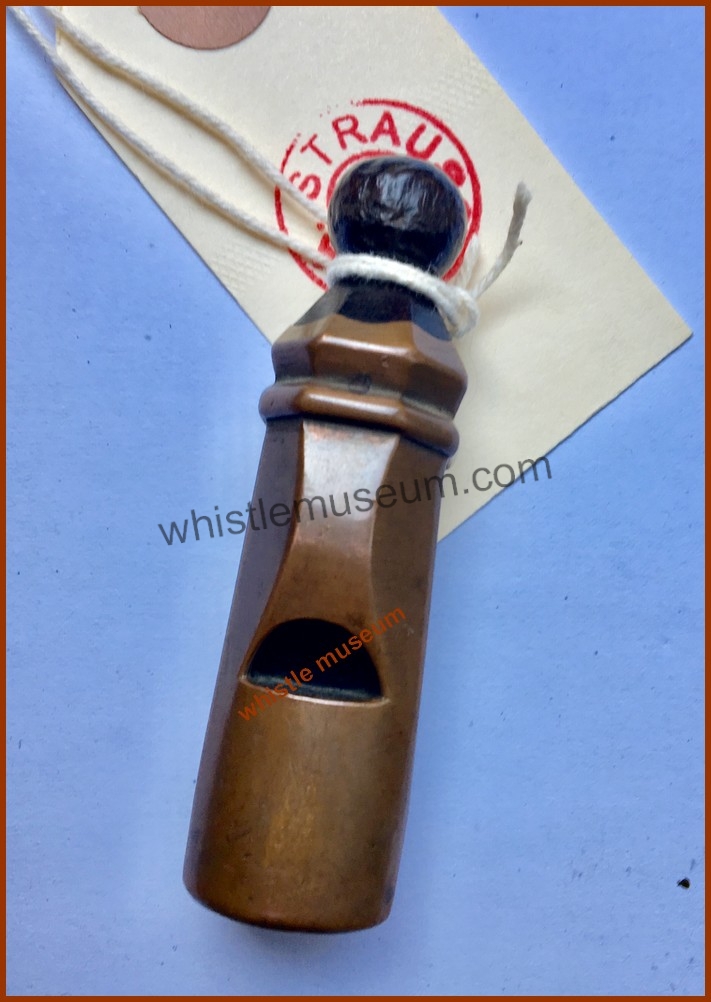
Materials: Gun Metal (a type of bronze – an alloy of copper, tin, and zinc )
& painted extra hard wood.
L: 69 mm Continue reading A Military Round Pea Whistle 18th to Early 19th Century Design Masterpiece. A. Strauss
Whistles used as Bird Calls are a huge category,
Many of the hand operated type whistles vs. Mouth whistles use a Bellow,
There are few types of Bellows. This time I will review few pedal shape bellows
made of wood & leather. The operation is by hand & the term is used because of the shape albeit I think these could be played by the foot as well.
Here are few examples of Antique Bird Calls – Whistles, 19th century to early 1900, certainly a seldom met with type.
The French and European Continent Bird Calls & are very different than the American ones, and of the far east ones.
These I believed to be folk art work of rural hunters; Tin whistle combining a mechanical element, a Bellow – Pedal shaped Bellow & Whistle, but found out some stamped bellows.
I had looked through many catalogs of bird calls – whistle manufacturers from mid 19th Century onward and had never seen one in a catalogue.
There are four different calls here all from France & Neighbouring countries (Belgium) , I would be glad to see more if the reader happens to have.
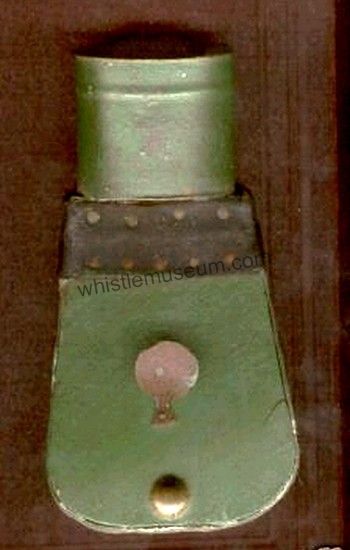
Next is one taken apart, the Tin whistle incorporating a button type whistle can be used inhaling or exhaling it seems that when attached to the Bellow it works by pressing the bellow and it omits a sound when released, but short lite press and release movements produce both sounds.
The calls are made of various materials including a Tin Whistle , Leather, wood, steel spring & iron nails.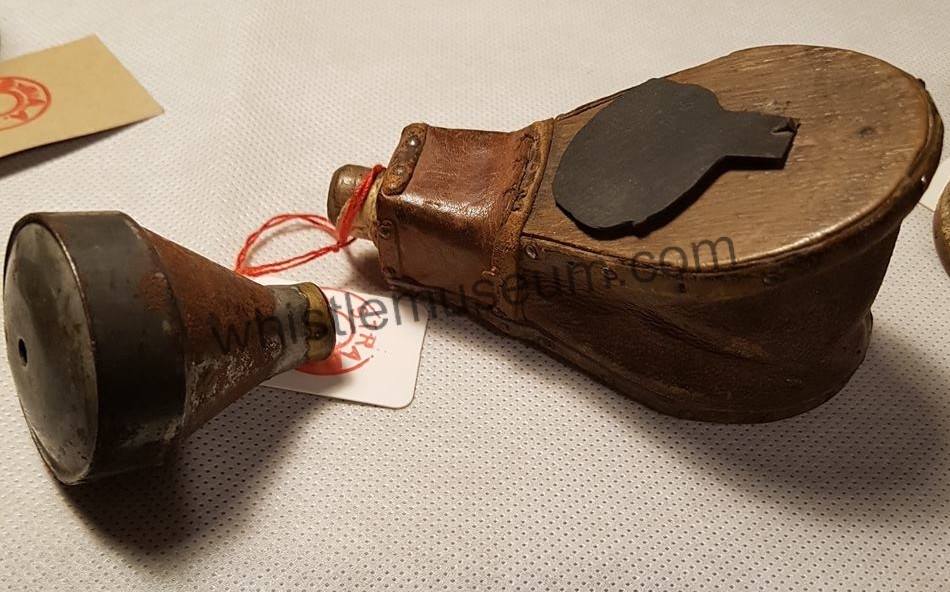
Samuel Auld started making whistles in the earlier part of the 1870s, after Joining Westwood (See another article about a previously unknown maker J. Westwood which I found) Auld partnership with Westwood at Globe Brass foundry 248 Gallowgate st. (Both were the sole partners dissolved on July 20 1877 and announced legally 31 October 1877.
Very few are known to exist, and each one is numbered on the side.
These are the only numbered police Snail whistles of this era.
The original numbering suggests that there were about 300 made
Highest known number is 369, as of now 3 or 4 are known to exist.
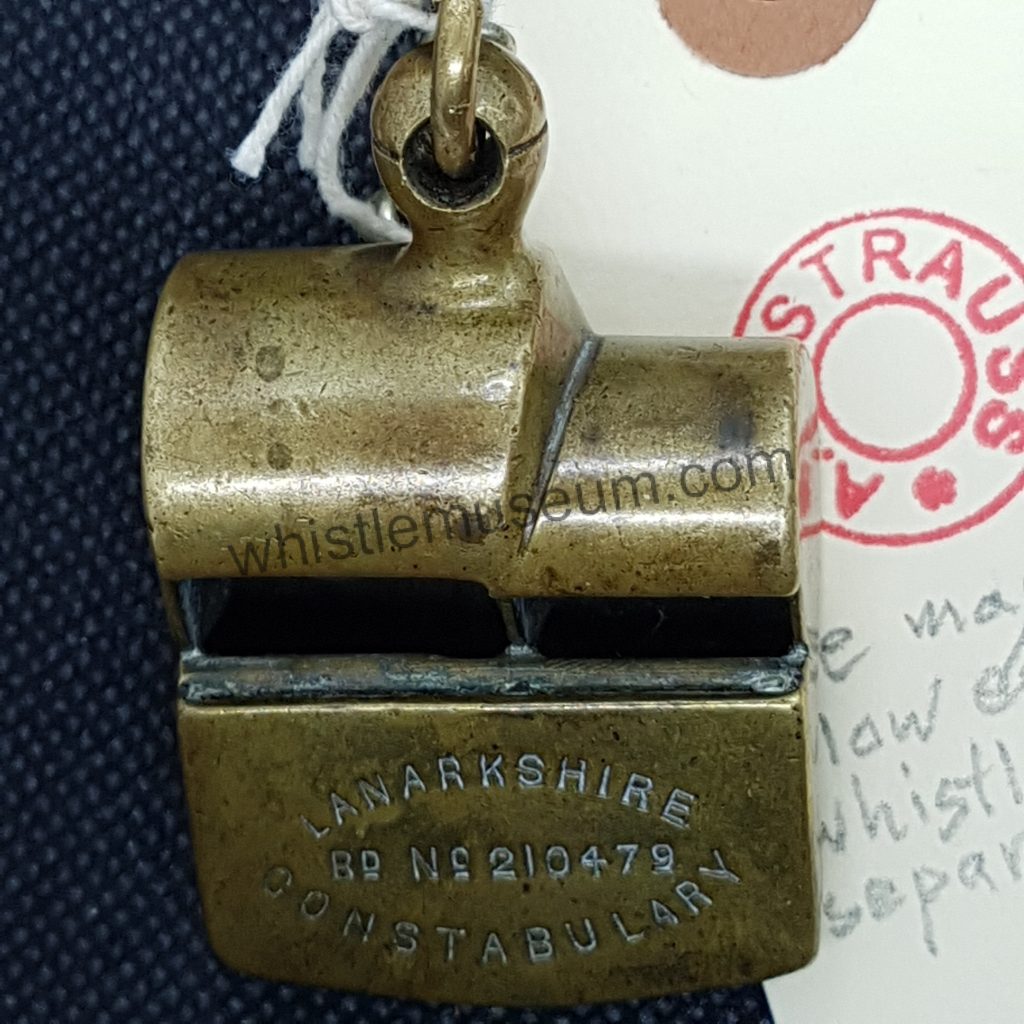
In 1877 Auld started his own Company on the same street (no. 240 later he would own and work from both 240 and 248) by 1878 he was listed as a well known Continue reading Samuel Auld The Greatest Glasgow Whistle Maker. A. Strauss
Early ‘Bobbie Whistle’, Whale-Bone Pea Whistle Pre Metropolitan Police Constable Whistle from Hill’s Family.
1821 Early ‘Peeler’, ‘Bobbie Whistle’,Whale-Bone Pea Whistle Pre Metropolitan Police Constable Whistle from Hill’s Family. The next email and photos I quote word for word with some private lines omitted, is from Mr. John Hill Noted for his Great Articles about Historic Places and Cultures among others.
I received it with answers to my questions, I chose to put Some technical and Family history in Bold letters.
Dear Avner
What a pleasant surprise it was to receive your friendly and interesting email. And what a treat it was to discover your fabulous website on whistles – it is absolutely wonderful – congratulations!
My father said it belonged to his great-great-grandfather who was a “Hill” who lived in London and was one of the early “Peelers” (also called “Bobbies” – after Robert or “Bobbie” Peel) or the specialist police set up on the suggestion of Sir Robert Peel in 1814 in Ireland and, in 1829, 1000 men were formed into the “Metropolitan Police Force” who were regularly referred to as “Peelers”. It apparently belonged to him and he carried it while at work. I was lucky enough to inherit it from my father.
We don’t know much about this distant ancestor as the family history seems to have been broken when my grandfather, Alfred Hodson Hill (1887-1977), moved c. 1910 to Montreal, Canada. Before that, his father (who was a silversmith and son of the “Peeler” who owned the whistle) and family moved to Sheffield from London at some unknown date in the 19th century.
That is about as far as the family stories go.
How lovely to hear back from you! I only wish my father was still alive – he would have been so excited to find someone so interested in his family heirloom.
It truly is a unique whistle – i have been very fond of it since childhood and always impressed with the fact that ti is undoubtedly unique.

The whistle is, as you know, carved in the shape of a whale in
(presumably) whale-bone – but maybe from sperm-whale teeth or walrus ivory – I wouldn’t know how to tell the difference – can you help with this? Also, would it be useful for me to gently rub it with mineral oil – or do you have another suggestion – or, should I just leave it alone ?
One blows through the mouth of the whale to make it whistle. It does have a dark brown “pea” (roughly 8 mm. in diameter) inside the whistle, and the hole (where the sound comes out) does not contain a reed or anything other than the original piece of whale bone – with a sharp-edged hole cut into it.
It is just about exactly 8 cm long, 3cm wide at the widest point, 2 cm high
at its highest point (on the top of the whale’s head),
and about 1.5 cm wide at the narrowest place.
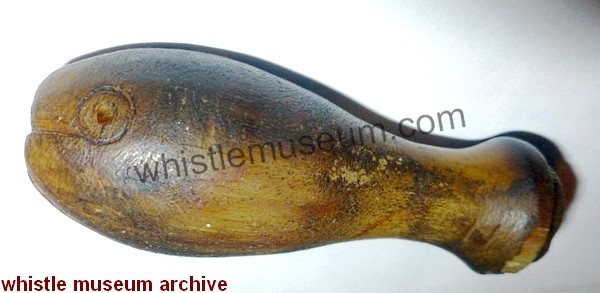
It still has a good-sounding loud, piercing whistle –
I still use it occasionally to call guests from a little cabin we have about 80 metres from our home.
Cheers
John
If I may add I believe the maker was a very fine skilled craftsman who hopefully made other whistles as well. It is also notable that it is a PEA WHISTLE.
Whistle Museum all rights reserved.
Contact: info@avnerstrauss.com
This is the last part about James Dixon & Sons Whistles and History
in 9 parts. (See links to all 9 parts at bottom).
I started the article with Two Note Tube whistle (TNT) the one commonly identified with police whistles and invented by Porteous for Stevens & Sons,
It was only in 2006 that I discovered the first one.
There are two known examples of this whistle,
Here is a Drawing of model # 55 in Dixon’s catalogue of 1895. The whistle was made before that, and was described as a railway whistle.
 Continue reading James Dixon & Sons Other Rare Whistles, Models & Designs. Part.II.c. Avner Strauss
Continue reading James Dixon & Sons Other Rare Whistles, Models & Designs. Part.II.c. Avner Strauss
Dixon & Sons Round Britannia Metal Whistles & Model #49.
James Dixon started making Britannia Metal (Invented c.1770) whistles Before 1850, Here is a group photo of 16 round pea britannia metal whistles,
11 of which were positively identified as made by Dixon & Sons, two were later found in a German (Marked as such).
Some marked X still need a second close examination dew to newly discovered catalogues by other makers.
Model #10 was made in two sizes, a distinctive Dixon’s Flushed Pillar Top Finial.
See the two sizes made in the group photo above top right is the larger model and 3rd from top left the smaller. 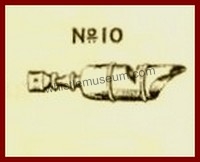 This model was made in two sizes, but other earlier versions are noted;
This model was made in two sizes, but other earlier versions are noted;
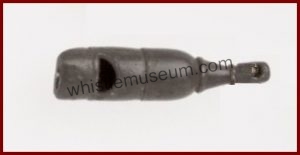 Continue reading Dixon & Sons Round Britannia Metal Whistles & Model #49. Part I.e. A Strauss
Continue reading Dixon & Sons Round Britannia Metal Whistles & Model #49. Part I.e. A Strauss
ROUND & ROUND PEA WHISTLES
This part starts with metal whistles (one wooden) excluding Britannia metal made whistles which are to be uploaded later, and continues with Ivory,
Horn & Stag horn made whistles. Materials & Identifying features for Dixon whistles would be discussed later. The Part dealing with round whistles terminating with an Animal Head can be viewed here, Part I here,The begining of Part II. a., Here.
Dew to the length PART I of the article was divided into 7 parts, all posted.
Dixon’s whistle’s timeline divided roughly to three periods over the 19th century;
Early – Pre 1835 Dixon, Dixon & Son
Middle – 1835 Dixon & Sons
Later 19th Century c. 1865 – 1900
The earliest whistles Dixon made were round whistles.
These were very sturdy cast or machined from one metal rod with no hole at top, the drilled hole came later, I believe the early ones were made mostly for military use. and later quality was upgraded in terms of materials and designs for the elite, sportsmen, and later for railways.
A very early type: A special knot was used to tie a lanyard to the whistle’s top;
A special knot was used to tie a lanyard to the whistle’s top;
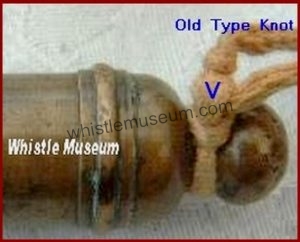 This whistle uses the “Sheffield Fipple” (a term I coined here) which is discussed in details, in a later paragraph here, and the round metal band below mouthpiece which may well be unique to Dixon (to be verified).
This whistle uses the “Sheffield Fipple” (a term I coined here) which is discussed in details, in a later paragraph here, and the round metal band below mouthpiece which may well be unique to Dixon (to be verified).
The next photo shows another very early Dixon on the left with the same features but a different top design, mushroom like.
A very early type beside the ‘next generation’
 Continue reading James Dixon & Sons Part I. a. Round Whistles. A.Strauss
Continue reading James Dixon & Sons Part I. a. Round Whistles. A.Strauss
This function has been disabled for Whistle Museum.